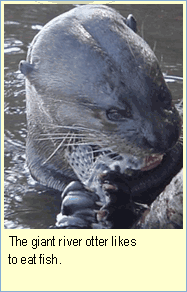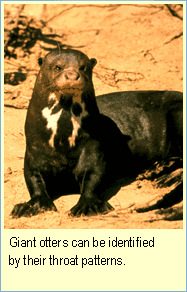| |
 The primary research task for the Earthwatch team of Hudson High School students in February is to assist Helen Waldemarin, the lead scientist for the Brazilian River Otter project. In several areas of Brazil the giant river otter is already extinct. Helen wants to find out why. Her goal is to find out what otters need in their natural habitat in order to protect them from humans and from extinction in the Pantanal. The primary research task for the Earthwatch team of Hudson High School students in February is to assist Helen Waldemarin, the lead scientist for the Brazilian River Otter project. In several areas of Brazil the giant river otter is already extinct. Helen wants to find out why. Her goal is to find out what otters need in their natural habitat in order to protect them from humans and from extinction in the Pantanal.
 video clip should read "this is video clip of Helen Waldemarin, lead
scientist, being interviewed by Hudson High School students. She describes what the Hudson High School students will be doing in the Pantanal. (Courtesy of Hudson high school students) video clip should read "this is video clip of Helen Waldemarin, lead
scientist, being interviewed by Hudson High School students. She describes what the Hudson High School students will be doing in the Pantanal. (Courtesy of Hudson high school students)
Waldemarin has been studying otters for over seven years She began working with Earthwatch teams in the Pantanal over a year ago. Her passion for the otters is obvious. As one Earthwatch team member reported, "You can tell by the way her entire face lights up when she recounts the latest escapades of 'Casper,' 'Lipstick,' or any of the other otters she has come to know."
 The otters are very social and curious animals. They are also easy to observe playing along the banks of the Rio Negro. Individual giant otters can be identified by the cream colored patterns on their throats. Waldemarin is collecting basic information on two species of otters: the neotropical otter and the giant river otter. You can find out more about these species at: www.otternet.com and www.giantotters.com.
The otters are very social and curious animals. They are also easy to observe playing along the banks of the Rio Negro. Individual giant otters can be identified by the cream colored patterns on their throats. Waldemarin is collecting basic information on two species of otters: the neotropical otter and the giant river otter. You can find out more about these species at: www.otternet.com and www.giantotters.com.
Waldemarin is particularly interested in knowing more about the relationships of the two otter species. Which dens and resting sites do they use? What food do they eat? Do they fish in the same places? What is the size of the groups? Is there conflict between the groups?
 this video clip of Helen Waldemarin as she describes the importance of her research. (Courtesy of Hudson high school students) this video clip of Helen Waldemarin as she describes the importance of her research. (Courtesy of Hudson high school students)
To answer these questions, Earthwatch teams and Hudson students help with varied research tasks. They:
- search for dens and resting sites along the riverbanks;
- record den characteristics such as their exact locations, measurements, and use;
- observe otter behavior to identify individuals, structure of family groups, and cubs;
- collect otter scats, or droppings, to determine prey and other food items eaten by each species.
In addition to otters, Hudson students are also engaged in other related research studies at the Pantanal. Daily they record the locations of mammals they see, monitor animal tracks, and collect animal food and fruit samples. By working on several different research projects, the students experience the interconnectedness of the different parts of the ecosystem. They get the "big picture" view of the Pantanal, and the importance of conserving this unique environment.
Top photo courtesy
of Amy Biasucci. Bottom photo courtesy of Melinda Nye.
|
 |

